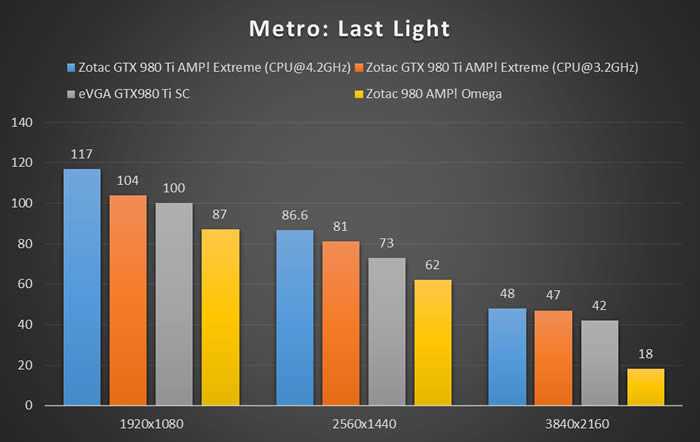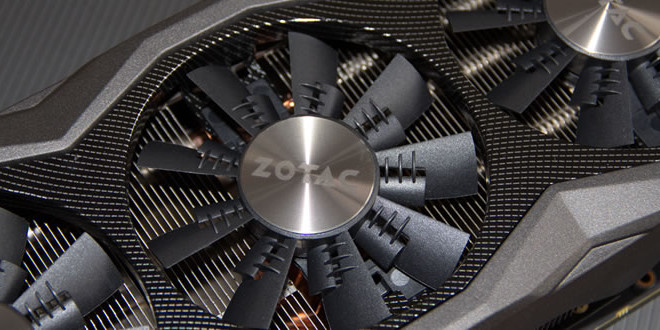Metro Last Light
Metro: Last Light is the sequel to Metro 2033. Published by Ukrainian game studio 4A Games, it is set in the same post-apocalyptic future as its predecessor, where mankind tries to survive in the underground of Moscow’s Metro. The story takes you through claustrophobic tunnels where you fight both humans and mutants. Each step takes you closer toward revealing a dark future and the possibility to prevent it.
Just like in the last title, the 4A Engine is used. It fully supports DirectX 11, Tessellation and Physics, we test with Physics turned off.

Again we see less performance improvements at 1080p, mostly due to being CPU bound there, while 1440p gives us a nice 16% boost in framerates over the eVGA GTX 980 Ti SC while 2160p givethat still gives us 5 more fps (+12%), still not enough for 60 fps average.
Metro: Last Light Settings
| All resolutions |
|
 Bjorn3D.com Bjorn3d.com – Satisfying Your Daily Tech Cravings Since 1996
Bjorn3D.com Bjorn3d.com – Satisfying Your Daily Tech Cravings Since 1996










How are you providing SLI results with a slower card in the pool? The Zotac clocks down to match the slower card to create equal performance. Essentially you posted results of the eVga card in SLI mode, not the Zotac. Also, the system you are benching on appears to be gen 2 not gen 3 pcie. You’re not getting the full 40 lanes out the Zotac… I assume these things will have an effect on your test results, no? i have this Zotac card and feel with the configuration and testing method you didn’t do it justice, it’s my first Zotac, coming from eVga 780 then 980’s all in SLI and find the new AMP Extreme a mind blowing experience. Extremely curious to see a what a “real” real-world test of two AMP! Extremes running in SLI with full gen 3 support active.
Well, until I get two of these cards to play with any SLI-tests will be affected by the difference in clockspeed. That said I could follow the clock speed in GPU-Z and each card was actually running at their relative speeds so it doesn’t seem it is clocking down – however it needs to be in sync so yes, we do get a bit slower SLI-results than we could get. The SLI numbers though is more to show what SLi can do for you. you are correct that I am rocking on an older gen mobo/CPU which I noted in my test-rig info and I am in the process of swapping everything out for Skylake the coming days so unless Zotac needs the card back ASAP i hope to get some new SLi-testing in during next week.
I just picked up a Skylake i7-6700K and the ASUS Z710 Deluxe (http://www.asus.com/US/Motherboards/Z170-DELUXE/) and will instalkl everything and then do some SLI-testing to see if the scaling changes.
Might be powerful, but I don’t trust Zotac 😛
Zotac is a more reliable edition compared to the plain but you’ll never get anything special and you’re likely to pay more. Then again if you’re looking for a more stable version of a unit where the special things like the 20th edition 980 for example mean nothing, zotac is the way to go.
I’ve tested a bunch of Zotac cards and their AMP! edition cards always worked well and provided nice overclocking featrures and good cooling. Still, even the “reference” cards of the 980 Ti overclock well so in the end you have to see how much you value factory overclocking and different coolers.
A fan of Zotac. They get the most out of their GPU’s but as a result, suffer limited longevity. I’ve had 2 of their cards die on me, roughly as I was just about to upgrade to the next version. Meanwhile all stock frequency cards I have from other brands (as far back as GeForce3) live to this day. On most cards the fans will wear out after about 3-4 years of regular use. In Zotac cards the GPU has a similar lifespan, which shouldn’t be an issue if you’re chasing high frequencies and tend to upgrade often.
May as well buy reference card
At that price I’d rather get a FuryX…